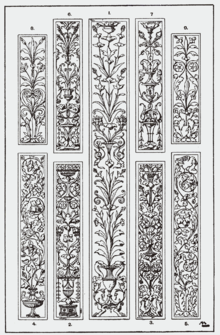
Margent is a vertical arrangement of flowers, leaves or hanging vines used as a decorative ornament in architecture and furniture design in the 16th, 17th and 18th centuries. This motif was developed as a complement to other decorative ornaments, hanging as "drops" at the ends of a festoon or swag. Also used to accentuate the vertical lines of window frames and centered in ornamental panels.
The term margent is an archaic word meaning "margin", a border or edge; especially handwriting on the edges of a printed book (or marginalia). Related to the word "marches", the area between two regions.
Shakespeare uses the word in Act II, Scene I of A Midsummer Night's Dream:
These are the forgeries of jealousy
And never, since the middle summer's spring,
Met we on hill, in dale, forest or mead,
By paved fountain or by rushy brook,
Or in the beached margent of the sea,
To dance our ringlets to the whistling wind,
But with thy brawls thou hast disturb'd our sport.
Beached Margent of the Sea is also the name of a painting by Canadian artist, F.M. Bell-Smith (1846–1923).
Gallery[edit]
-
Renaissance margent on the San Lorenzo Tabernacle, by Desiderio da Settignano and Baccio da Montelupo, 1461, marble, Basilica of San Lorenzo, Florence, Italy
-
Renaissance margents on two pilasters of the entrance of the Santa Maria dei Miracoli, Venice, by Pietro Lombardo, 1481-1489
-
Renaissance margents on two pilasters in Hôtel d'Alluye, Blois, France, unknown architect or sculptor, 1498 (or 1500)-1508
-
Renaissance Revival margents on pilasters of the Hielanman's Umbrella, Glasgow, UK, unknown architect, 1879
-
Renaissance Revival margent on a pilaster of the Dimitrie Sturdza House (Strada Arthur Verona no. 13-15), Bucharest, Romania, unknown architect, 1883[1]
-
Renaissance Revival margent on a pilaster of Strada Grigore Cobălcescu no. 18, Bucharest, unknown architect, c.1890
See also[edit]
References[edit]
- ^ "Palais du Commerce". pop.culture.gouv.fr. Retrieved 18 September 2023.
- Lewis, Philippa; G. Darley (1986). Dictionary of Ornament. New York: Pantheon. ISBN 0-394-50931-5.
- Swan, Abraham (1757). Collection of Design in Architecture. Volume II
- Meyer, Franz Sales (1898). Handbook of Ornament.





![Renaissance Revival margent on a pilaster of the Dimitrie Sturdza House (Strada Arthur Verona no. 13-15), Bucharest, Romania, unknown architect, 1883[1]](https://upload.wikimedia.org/wikipedia/commons/thumb/d/da/Detail_of_the_pilaster_between_a_pair_of_windows%2C_on_the_D.A._Sturdza_House_from_Bucharest_%28Romania%29.jpg/241px-Detail_of_the_pilaster_between_a_pair_of_windows%2C_on_the_D.A._Sturdza_House_from_Bucharest_%28Romania%29.jpg)


Well, that’s interesting to know that Psilotum nudum are known as whisk ferns. Psilotum nudum is the commoner species of the two. While the P. flaccidum is a rare species and is found in the tropical islands. Both the species are usually epiphytic in habit and grow upon tree ferns. These species may also be terrestrial and grow in humus or in the crevices of the rocks.
View the detailed Guide of Psilotum nudum: Detailed Study Of Psilotum Nudum (Whisk Fern), Classification, Anatomy, Reproduction